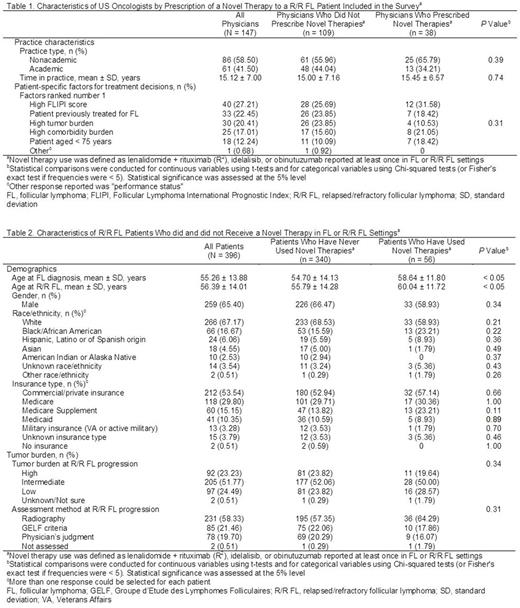Abstract
Introduction: The recent inclusion of novel therapies such as lenalidomide + rituximab (R2), idelalisib, and obinutuzumab in clinical guidelines has expanded treatment options for patients with relapsed/refractory follicular lymphoma (R/R FL). However, limited real-world evidence is available that characterizes patient and physician use of novel therapies as opposed to older regimens (e.g. R-CHOP [rituximab, cyclophosphamide, doxorubicin, vincristine, and prednisone], and R-CVP [rituximab, cyclophosphamide, vincristine, and prednisone]).
Methods: Real-world data were extracted by US-based oncologists participating in a retrospective, panel-based chart review. Oncologists provided practice-related information and extracted chart data for eligible patients, including demographics, tumor burden, and treatment history. Eligible patients were aged ≥ 18 years at follicular lymphoma (FL) diagnosis, progressed to R/R FL between January 2013 and January 2016, and were treated by an oncologist from the time of their initial FL diagnosis. Characteristics were compared between physicians who provided charts for patients receiving novel therapies for R/R FL versus those who did not, and between patients who received novel therapies versus those who did not. The novel therapies considered were R2, idelalisib, and obinutuzumab, prescribed at least once in the FL or R/R FL settings.
Results: The sample included 396 charts from patients diagnosed with R/R FL contributed by 147 oncologists. Of the oncologists, 25.8% (n = 38) had prescribed a novel therapy to a patient included in the study. Average time in practice was approximately 15 years and most practiced in nonacademic settings (58.5%; n = 86). The most frequently prioritized patient-specific factor for making treatment decisions was a high Follicular Lymphoma International Prognostic Index (FLIPI) score (Table 1). In the R/R FL patient charts reviewed, 14.1% (n = 56) reported novel therapy use, of which approximately half received R2 (51.8%; n = 29), 26.7% (n = 15) received idelalisib, and 23.2% (n = 13) received obinutuzumab (data not shown). On average, novel therapy users were diagnosed with FL and progressed to R/R FL by age 60 years (mean ± standard deviation [SD]: age at FL diagnosis 58.64 ± 11.80 years; age at R/R FL diagnosis 60.04 ± 11.72 years). Novel therapy users were distributed across genders (male 58.9%; n = 33), races/ethnicities (White 58.9% [n = 33]; Black/African American 23.2% [n = 13]), and insurance types (commercial 57.1% [n = 32]; Medicare 30.4% [n = 17]). Physician-rated tumor burden at R/R FL progression among novel therapy users varied, with 50.0% reporting intermediate tumor burden, 28.6% low tumor burden, and 19.6% high tumor burden. Radiography (64.3%; n = 36) was the most commonly used assessment method for tumor burden (Table 2).
Few differences were observed between physicians who provided charts for patients receiving novel therapies versus those who did not. Surveyed physicians were similar in practice setting, years in practice, and patient-specific factors prioritized in treatment decisions for FL and R/R FL, regardless of whether they prescribed novel therapies (Table 1). Likewise, patients with R/R FL who received novel therapies were generally similar to their counterparts who did not receive novel therapies. Although novel therapy patients were generally older than nonnovel therapy patients at initial FL diagnosis (mean ± standard deviation [SD]: 58.64 ± 11.80 vs 54.70 ± 14.13 years; P < 0.05) and age of R/R disease (mean ± standard deviation [SD]: 60.04 ± 11.72 vs 55.79 ± 14.28 years; P < 0.05), no differences were observed between the groups in terms of race/ethnicity, insurance type, tumor burden at progression to R/R FL, and tumor burden assessment method (Table 2).
Conclusions: Characteristics were similar between oncologists who did and did not prescribe novel therapies to patients, and between patients treated with novel and nonnovel therapies. These findings suggest that novel therapies (i.e., R2, idelalisib, or obinutuzumab) are being used in the R/R FL population, and have not been limited to specific practice settings, or reserved for patients with particular demographic or disease profiles.
Signorovitch: Analysis Group, Inc.: Employment; Celgene: Other: Employee of Analysis Group Inc., which received funding from Celgene Corporation for this research. Garcia-Horton: Celgene: Other: Employee of Analysis Group Inc., which received funding from Celgene Corporation for this research; Analysis Group, Inc.: Employment. Ricculli: Celgene: Other: Employee of Analysis Group Inc., which received funding from Celgene Corporation for this research; Analysis Group, Inc.: Employment. McGuire: Celgene: Employment, Equity Ownership.
Author notes
Asterisk with author names denotes non-ASH members.


